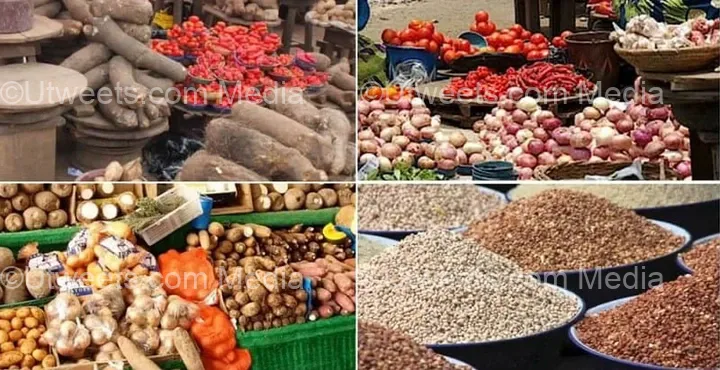|V!RAL V!D£O OF PAST0R DAUGHT£R M!STAK£NLY S£ND H£R NVD£ V!D£0 M£ANT F0R H£R BOYFR!END T0 CHURCH WHATSAPP CH0!R GR0UP|This period is marked by increased demand for various goods, which, coupled with infrastructural and economic factors, often leads to significant price hikes. Below is a detailed breakdown of how and why food prices tend to escalate during festive seasons: ...Tap To Read The Full Story Here | ..Tap To Read The Full Story Here...
1. Increased Demand
The festive season sees a surge in demand for food items as families and communities prepare for large-scale celebrations:
Staples: Commonly consumed items like rice, beans, yam, and garri see a spike in demand as they form the basis of most festive meals.
Protein Sources: Meat, chicken, and fish experience higher demand as they are staples for festive feasts.
Seasonal Produce: Fruits and vegetables used for salads and desserts also see increased consumption.
The sharp rise in demand often outpaces supply, leading to price hikes across markets.
2. Speculative Hoarding by Traders
Some traders exploit the festive season by hoarding food items in anticipation of higher prices:
Artificial Scarcity: By withholding goods, traders create an illusion of scarcity, driving up prices.
Profit Maximization: The seasonal rush gives traders an opportunity to inflate prices, knowing that consumers are less price-sensitive during the festivities.
3. Transportation Challenges
The movement of goods from rural farming areas to urban markets becomes more challenging during the festive season:
Increased Traffic: Higher travel volumes during the holidays lead to traffic congestion, delaying the transportation of perishable goods.
Higher Transportation Costs: Transport fares rise due to increased demand for vehicles, with these costs transferred to consumers.
4. Seasonal Agricultural Patterns
The festive season often coincides with the dry season, which can affect food supply:
Limited Harvests: Farmers focus more on off-season crops during this period, leading to reduced availability of staple foods.
Storage Costs: Perishable goods require additional costs for preservation, which are passed on to buyers.
5. Inflation and Economic Pressures
Economic factors exacerbate the seasonal price fluctuations:
Currency Depreciation: A weaker naira increases the cost of imported food items such as rice and cooking oil, which are staples during the festive season.
Inflation: General inflation, exacerbated by festive spending, raises the cost of both local and imported food products.
6. Festive Bonuses and Disposable Income
During the festive period, many Nigerians receive bonuses, allowances, or gifts, increasing their purchasing power. While this boosts spending, it also creates a price surge:
Willingness to Spend: Consumers are less sensitive to price changes due to higher disposable income.
Price Adjustment: Traders capitalize on this increased spending capacity by raising prices.
7. Cultural Practices and Community Giving
The Nigerian culture of generosity during the festive season also contributes to price hikes:
Bulk Purchases: Many families buy food in bulk to share with neighbors and less privileged members of society.
Feast Preparations: Large quantities of food are prepared for communal gatherings, further driving demand.
8. Impact of Festive Events
Festivals, weddings, and end-of-year parties held during the festive period lead to a rise in food consumption:
Catering Demand: Event planners and caterers purchase food items in large quantities, reducing market supply for individual buyers.
Competition: The high demand from commercial buyers intensifies the pressure on prices.
Examples of Price Trends During Festive Seasons
Rice: The price of a 50kg bag of rice can rise by 20–40% in December compared to other months.
Chicken: Live chicken prices often double in urban markets as demand peaks.
Vegetables: Tomatoes and peppers, essential for Nigerian stews, see price increases due to both higher demand and limited supply.
Mitigation Measures
To manage the impact of festive price surges, the following measures can be adopted:
Government Intervention: Regulatory agencies can monitor and prevent speculative hoarding by traders.
Subsidies: Temporary subsidies on transport costs can help stabilize food prices.
Market Expansion: Encouraging farmers to supply directly to urban markets can reduce middlemen costs.
Consumer Awareness: Educating consumers on effective budgeting and bulk purchasing before the festive rush can alleviate demand pressures.
Here is the price of major food commodities this week:
Price Of Bag Of Rice
50kg Nigeria Stone Free Tomato Bag of Rice – ₦82,000
My Choice Bag of Rice – ₦96,000
25kg Bag of Rice – ₦47,500
Price Of Bag Of Beans
Sweet Pure Butter Beans 50kg – ₦160,000
Brown Beans 50kg From Maiduguri – ₦90,000
A Rubber of Brown Beans – ₦7,500
Clean Hand Picked Oloyin Beans (Honey Beans) 50kg – ₦175,000
Soyabeans Very Dried – ₦130,000
Peleed Beans for Moi Moi 20kg – ₦80,000
Neat and Picked Pure Oloyin Sweet Beans 2.5kg – ₦8,500
Price Of Bag Of Garri
One Paint Of Garri – ₦3,900
Bag Of Garri 50kg – ₦55,000
100 kg Bag of Garri – ₦100,000
Tomatoes
Fresh derica tomatoes Big basket – ₦180,000
Fresh Tomatoes Basket – ₦55,000
Royal Sun Plum Tomatoes By 24 Cans – ₦32,000
Price Of Spaghetti
Golden Penny Spaghetti (500g × 20) cartoon – ₦28,000
Price Of Palm Oil
5 litre gallon – ₦7,500
25 litre gallon – ₦45,500
Onions
One bag – ₦180,000.…Read The Full Story From Source
Irish Potatoes
One Basket – ₦75,000|V!RAL V!D£O OF PAST0R DAUGHT£R M!STAK£NLY S£ND H£R NVD£ V!D£0 M£ANT F0R H£R BOYFR!END T0 CHURCH WHATSAPP CH0!R GR0UP|



